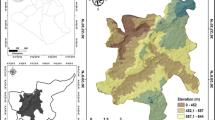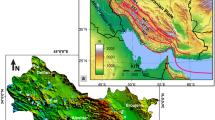Abstract
In this study, an attempt was made to re-evaluate and compare landslide susceptibility in a landslide-prone area in the West Black Sea Region of Turkey, using expert opinion and the analytical hierarchy process (AHP). In order to compare the results with a landslide susceptibility study undertaken previously in the same region using the artificial neural network (ANN) method, slope angle, slope aspect, topographical elevation, topographical shape, water conditions and vegetation cover parameters were taken into consideration. Experts were asked to rate their pairwise importance and their feedback was used in the AHP to produce a landslide susceptibility map of the study region. Its validity was tested using relation value (r ij ) and the areal frequency distribution of the actual landslides in the area. The results were satisfactory and similar to those achieved in the previous ANN study. It is concluded that AHP can be a useful methodology in landslide susceptibility assessment.
Résumé
Des experts ont été invités à évaluer d’leurspart l’importance de ces parameters et leur rétroaction a été employée dans l’AHP pour produire une carte de susceptibilité d’éboulement de la région etudiée. Sa validité a été examinée utilisant la valeur de relation (rij) et la distribution de fréquence régionale des éboulements réels dans le secteur. Les résultats étaient satisfaisants et semblables à ceux réalisés dans l’étude précédente. On conclut que le PHA peut être une méthodologie utile dans l’évaluation de susceptibilité d’éboulement.







Similar content being viewed by others
References
Abdolmasov B, Obradovic I (1997) Evaluation of geological parameters for landslide hazard mapping. In: Marinos PG, Koukis GC, Tsiambaos GC, Stournaras GC (eds) Proceedings of international symposium on engineering geology and environment, 23–27 June 1997, Athens, Balkema, Greece, pp 471–476
Akartuna M (1953) Caycuma–Devrek–Yenice–Kozcagız bolgesinin jeolojisi hakkında rapor (in Turkish). MTA yayinlari, Derleme no. 2059, 44 pp
Akgun A, Bulut F (2007) GIS-based landslide susceptibility for Arsin-Yomra (Trabzon, North Turkey) region. Environ Geol 51:1377–1387
Aleotti P, Chowdhury R (1999) Landslide hazard assessment: summary review and new perspectives. Bull Eng Geol Environ 58:21–44
Ayalew L, Yamagishi H, Marui H, Kano T (2005) Landslides in Sado Island of Japan: Part II. GIS-based susceptibility mapping with comparisons of results from two methods and verifications. Eng Geol 81:432–445
Barredo JI, Benavides A, Hervas J, Van Westen CJ (2000) Comparing heuristic landslide hazard assessment techniques using GIS in the Trijana basin, Gran Canaria Island, Spain. JAG 2(1):9–23
Brabb EE (1984) Innovative approaches to landslide hazard and risk mapping. In: Proceedings of 4th international symposium on landslides, vol 1. Canadian Geotechinacal Society, Toronto, Canada, pp 307–374
Can T, Nefeslioglu AH, Gokceoglu C, Sonmez H, Duman TY (2005) Susceptibility assessments of shallow earthflows triggered by heavy rainfall at three catchments by logistic regression analyses. Geomorphology 72(1–4):250–271
Carrara A, Cardinali M, Detti R, Guzzetti F, Pasqui V, Reichenbach P (1991) GIS techniques and statistical models in evaluating landslide hazard. Earth Surf Process Landf 16:427–445
Cevik E, Topal T (2003) GIS-based landslide susceptibility mapping for a problematic segment of the natural gas pipeline, Hendek (Turkey). Environ Geol 44(8):949–962
Deveciler E (1986) Alapli–Bartin–Cide (B. Karadeniz) jeoloji raporu (in Turkish). MTA yayinlari, Derleme no. 7938, 58 pp
Duman TY, Can T, Emre O, Kecer M, Dogan A, Ates A, Durmaz S (2005) Landslide inventory of northwestern Anatolia, Turkey. Eng Geol 77(1, 2):99–114
Duman TY, Can T, Gokceoglu C, Nefeslioglu HA, Sonmez H (2006) Application of logistic regression for landslide susceptibility zoning of Cekmece Area, Istanbul, Turkey. Environ Geol 51:241–256
Eastman JR (2003) IDRISI Kilimanjaro, guide to GIS and image processing, user’s guide (Ver.14). Clark University Press, Massachusetts
EMRC (Environmental Management Research Center) (2002) Map Window (Ver. 2.7.21). Logan, Utah State University
Ercanoglu M (2003) Bulanik mantik ve istatistiksel yontemlerle heyelan duyarlilik haritalarinin uretilmesi: Bati Karadeniz Bolgesi (Kumluca Guneyi-Yenice Kuzeyi) (in Turkish). H.U. Fen Bil. Enst. Doktora Tezi, Ankara, 202 pp
Ercanoglu M (2005) Landslide susceptibility assessment of SE Bartin (West Black Sea region, Turkey) by artificial neural networks. Nat Hazards Earth Syst Sci 5:979–992
Ercanoglu M, Gokceoglu C (2002) Assessment of landslide susceptibility for a landslide-prone area (north of Yenice, NW Turkey) by fuzzy approach. Environ Geol 41:720–730
Ercanoglu M, Gokceoglu C (2004) Use of fuzzy relations to produce landslide susceptibility map of a landslide prone area (West Black Sea Region, Turkey). Eng Geol 75:229–250
Ercanoglu M, Gokceoglu C, Van Asch Th WJ (2004) Landslide susceptibility zoning of north of Yenice (NW Turkey) by mutivariate statistical techniques. Nat Hazards 32:1–23
Ercanoglu M, Temiz N, Kasmer O (2006) Investigation of the utilization of fuzzy logic and artificial neural networks on producing landslide susceptibility maps (in Turkish). TUBITAK-CAYDAG, Project No: 103Y126, 186 pp
Gokceoglu C, Ercanoglu M (2002) An inventory study on the landslides in the north of Yenice region (NW Turkey). In: 9th congress of the international association for engineering geology and the environment, Durban, S. Africa, p 166
Gokceoglu C, Sonmez H, Nefeslioglu HA, Duman TY, Can T (2005) The 17 March 2005 Kuzulu landslide (Sivas, Turkey) and landslide-susceptibility map of its near vicinity. Eng Geol 81(1):65–83
Guzzetti F, Carrara A, Cardinali M, Reichenbach P (1999) Landslide hazard evaluation: a review of current techniques and their application in a multi-scale study, Central Italy. Geomorphology 31:181–216
Komac M (2006) A landslide susceptibility model using the analytical hierarchcy process method and multivariate statistics in perialpine Slovenia. Geomorphology 74:17–28
Moore ID, O’Loughlin EM, Burch GJ (1988) A contour-based topographic model for hydrological and ecological applications. Earth Surf Process Landf 14(4):305–320
Nefeslioglu HA, Duman TY, Durmaz S (2008) Landslide susceptibility mapping for a part of tectonic Kelkit Valley (Eastern Black Sea region of Turkey). Geomorphology 94:401–418
Saaty TL (1977) A scaling method for priorities in hierarchical structures. J Math Psychol 15:234–281
Suzen ML, Doyuran V (2004a) Data driven bi-variate landslide susceptibility assesment using geographical information systems: a method and application to Asarsuyu catchment, Turkey. Eng Geol 71(3, 4):303–321
Suzen ML, Doyuran V (2004b) A comparison of the GIS based landslide susceptibility assessment methods: multivariate versus bi-variate. Environ Geol 45(5):665–679
Timur E, Aksay A, Celik B (1997) Zonguldak F-28 paftasi 1/100000 olcekli jeoloji haritasi. MTA Gn. Md., Jeoloji Etudleri Dairesi (in Turkish)
Tunusluoglu MC, Gokceoglu C, Sonmez H, Nefeslioglu HA (2007) An artificial neural network application to produce debris source areas of Barla, Besparmak, and Kapi Mountains (NW Taurids, Turkey). Nat Hazards Earth Syst Sci 7:557–570
Van Westen CJ (1997) Statistical landslide hazard analysis, ILWIS 2.1 for Windows application guide. ITC Publication, Enschede, pp 73–84
Van Westen CJ (2000) The modelling of landslide hazards using GIS. Surv Geophys 21:241–255
Varnes DJ (1978) Slope movement types and processes. In: Schuster RL, Krizek RJ (eds) Landslides analysis and control. Transportation Research Board, National Academy of Sciences, Special report no.176, pp 12–33
Yesilnacar E, Topal T (2005) Landslide susceptibility mapping: a comparison of logistic regression and neural networks methods in a medium scale study, Hendek region (Turkey). Eng Geol 79:251–266
Acknowledgments
The authors would like to thank the experts who have contributed significant to the manuscript; the work being based on their valuable opinions. The authors also would like to thank Assoc. Prof. Dr. Harun Sonmez for his valuable comments and contributions to the manuscript. The authors would like to give their special thanks to GIS Specialist Jill Norton, from Idaho, USA, for her valuable comments and English editing. This research is supported by the Scientific and Technical Research Council of Turkey (TUBITAK) (Project No: 103Y126).
Author information
Authors and Affiliations
Corresponding author
Rights and permissions
About this article
Cite this article
Ercanoglu, M., Kasmer, O. & Temiz, N. Adaptation and comparison of expert opinion to analytical hierarchy process for landslide susceptibility mapping. Bull Eng Geol Environ 67, 565–578 (2008). https://doi.org/10.1007/s10064-008-0170-1
Received:
Accepted:
Published:
Issue Date:
DOI: https://doi.org/10.1007/s10064-008-0170-1




